Top News
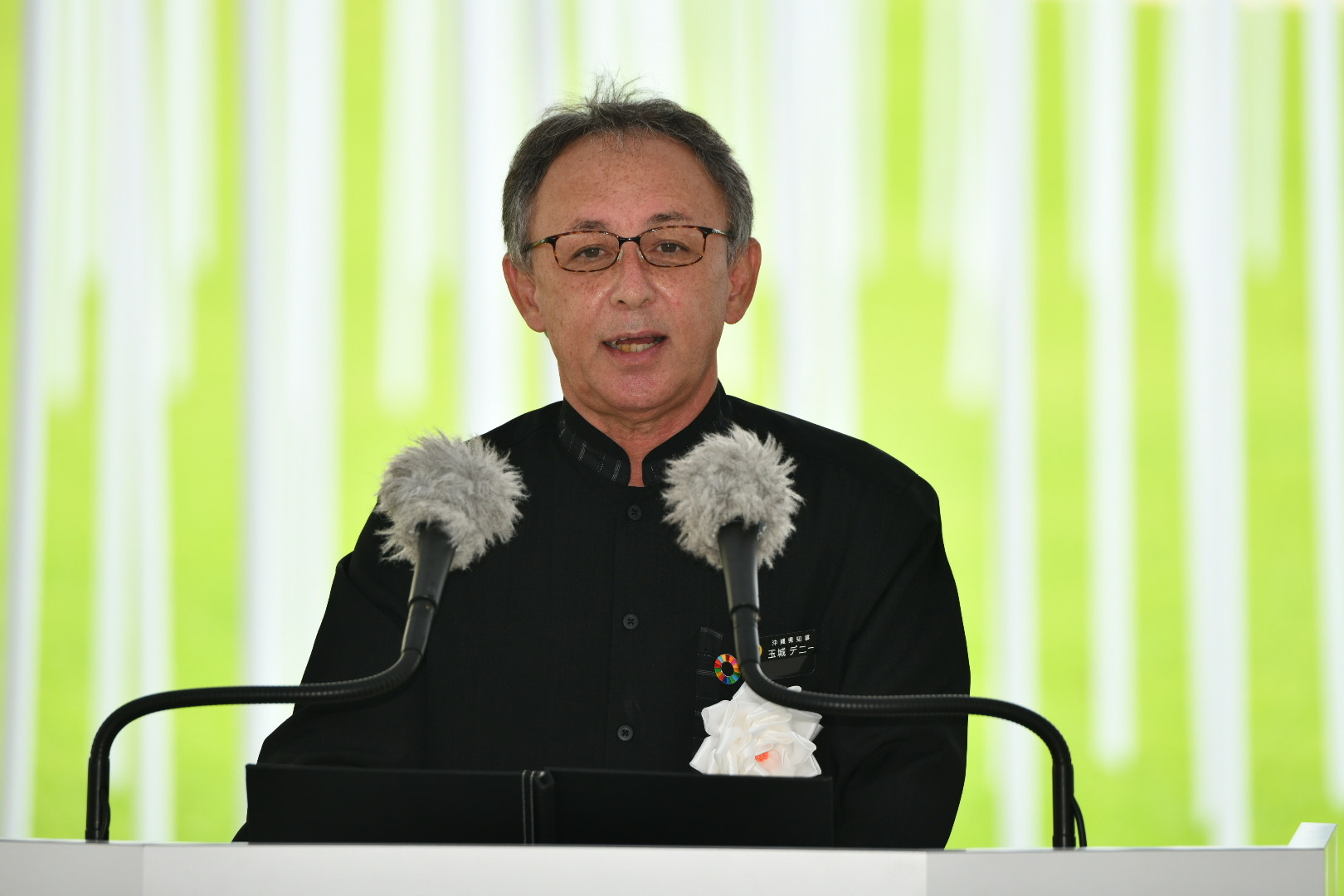
June 23, 2020 Ryukyu Shimpo
This year’s Okinawa Memorial Day marked the 75th anniversary since the end of the Battle of Okinawa. The Okinawa Prefectural Assembly held the annual memorial day service to honor the war-dead on June 23 at the Peace Memorial Park in Mabuni, Itoman City, where the final and bloodiest battle of the war was fought. During the memorial service, Gov. Denny Tamaki delivered a peace declaration: “We must earnestly find a way to keep the war memory alive. I hereby declare my dedication to making Okinawa the center of peaceful interactions, so as to fulfill its role in actualizing world peace. Thereon, our nation can take pride in its pacifist, non-nuclear principles and come together with people from all over the world.” Just as with the previous year, the governor read parts of the peace declaration in the Okinawan language and in English.
■ Governor’s comments on Henoko
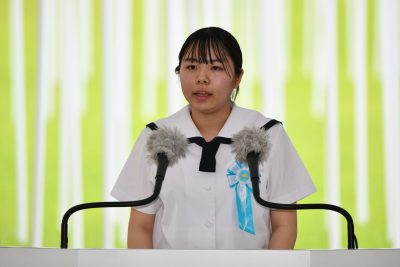
Photograph 2: Akane Takara reads Anata ga Ano Toki, her poem dedicated to peace, during the Okinawa Memorial Day ceremony at the Peace Memorial Park in Mabuni, Itoman City, on June 23, 2020.
In his peace declaration, Gov. Tamaki pointed out that even today, 75 years after WWII, 70.3% of all U.S. military bases in Japan are concentrated in Okinawa, while it accounts for 0.6% of the total land area of Japan. Tamaki argued that Okinawan lives continue to be heavily impacted by accidents and incidents caused by U.S. military personnel, and by environmental issues such as water pollution caused by U.S. military bases.
The governor spoke on Nago City’s Henoko/Oura Bay, where the new military base is currently under construction; he called the waters a “hope spot,” inhabited by over 5,300 animal species (of which 262 are endangered). He underscored the importance of “Thinking responsibly about how to preserve our abundant oceans and forests for the future generations.” He then commented on how the novel coronavirus pandemic wreaked havoc as rising anxiety and discrimination polarized society: “This shows how people around the world can benefit from accepting each other’s positions and differences, and from cooperating and trusting each other. It will allow us to have a peaceful heart and lead a truly rich life.” He declared, “Now is the time to rid of all nuclear weapons and wars, and place our utmost efforts into building lasting peace.”
The United Nations prepared a video message for the Okinawa Memorial Day service for the first time. Izumi Nakamitsu, the United Nations Under-Secretary-General of Disarmament Affairs, said in the video: “75 years after the Battle of Okinawa, tensions between certain global superpowers are on the rise. The world’s security environment has deteriorated; some call it a new cold war. On one hand, multinational cooperation is required in solving global issues such as the novel coronavirus pandemic, climate change, and sustainable development. On the other hand, foreign affairs can be multi-polarized and complex, and there’s a recent trend to downplay international frameworks and norms.” She concluded, “Now is the time for disarmament.” Nakamitsu further said, “The people of Okinawa overcame the tragedy of the Battle of Okinawa; they spent their lives rebuilding the islands from the ravages of war and building peace. Passing down their passion and their successes to the next generation, and working towards world peace is the way to honor the fallen.”
■ Hiroshima and Nagasaki mayors’ messages
Also for the first time, Hiroshima City Mayor Kazumi Matsui and Nagasaki City Mayor Tomihisa Taue prepared video messages for the memorial service. Both cities were destroyed by atomic bombs during WWII. Mayor Matsui called for lasting world peace and said, “Civil societies need to shift to sharing this common value that an ideal world is one without war or nuclear weapons.”
Due to the coronavirus pandemic, Prime Minister Abe, the chairs of both houses of the Diet, and some of the cabinet ministers were unable to attend the service this year. Prime Minister Abe said in his video message, “The atrocious warring shall not be repeated again. [We] resolve to keep this vow, build a peaceful world full of hope, and continue to persist in such efforts.” The Prime Minister then promised to make progress on reducing the military base hosting burden placed on Okinawa, however, refrained from commenting on the Henoko base construction.
After Gov. Tamaki’s peace declaration, Akane Takara, 17, a senior student at Shuri High School, read her poem dedicated to peace, titled Anata ga Ano Toki (literally: you at the time). Takara incorporated tragic stories told by WWII survivors into her poem. She is dedicated to “creating a peaceful world.”
The Okinawan governor had considered moving the location of the memorial service this year, from its usual venue to the National Cemetery for Okinawa’s war-dead. However, advisors argued that the move would acknowledge patriotic martyrdom. This incited public debate over the memorial day services as well as the pacifist government administration. In the end, the memorial day service was held at the usual venue.
Visitors arrived early in the morning to pray before the Cornerstone of Peace (Heiwa no Ishiji), a monument located inside the Memorial Park inscribed with the names of 241,593 people who lost their lives during WWII. Visitors mourned their fallen family members in the intermittent rain and wished for lasting peace. This year’s memorial day service was scaled down due to the coronavirus pandemic, and only 161 people attended, according to the organizers.
(English translation by T&CT and Monica Shingaki)
go to japanese
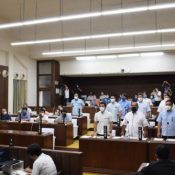
June 22, 2020 Ryukyu Shimpo Digital Edition
Ishigaki – The Ishigaki City Council (Hideyuki Taira, president) passed a resolution to rename an area under the city’s authority that contains the Senkaku Islands from “Tonoshiro” to Tonoshiro Senkaku” by majority vote during their final regular meeting of the month on June 22.
The move is bound to increase tensions with both China and Taiwan, who also claim ownership of the islands, affecting diplomacy with Japan’s neighbors.
(English translation by T&CT and Sam Grieb)
Photograph: Ishigaki city council voting to rename an area of the disputed Senkaku Islands. June 22, at the Ishigaki City Council
go to japanese
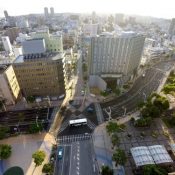
June 17, 2020 Ryukyu Shimpo
On June 16 the Ryukyu Shimpo, Okinawa Television Broadcasting (OTV), and JX News Agency finished jointly conducting a prefectural opinion survey in which respondents were asked to assess the issue of the Futenma Replacement Facility (FRF) contstruction in Henoko (Nago City), the Abe Cabinet, and Governor Denny Tamaki.
Results of the survey showed that with respect to a solution for the return/relocation of Futenma Air Station, the most popular answer at 30.28 percent of respondents was “unconditional closure/removal” of Futenma Air Station, 19.72 percent answered “relocate outside Okinawa”, 19.52 percent answered “relocate outside Japan”, and the cumulative total of these three answers amounted to 69.52 percent of respondents. 17.13 percent of respondents answered “relocate to Henoko, Nago City”, and 2.99 percent answered that relocation should take place “within Okinawa, but not to Henoko”.
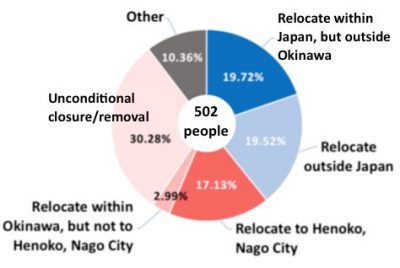
In the public opinion poll conducted by the Ryukyu Shimpo prior to the September 2018 Okinawa gubernatorial election, responses for “unconditional closure/removal” had accounted for 19.7 percent of respondents, and in a July 2019 survey prior to the House of Councilors election this answer accounted for 30 percent. Over the 24 years since the US and Japanese governments agreed to return Futenma Air Station to Okinawa, the inclination toward calling for unconditional closure/removal has been strengthening.
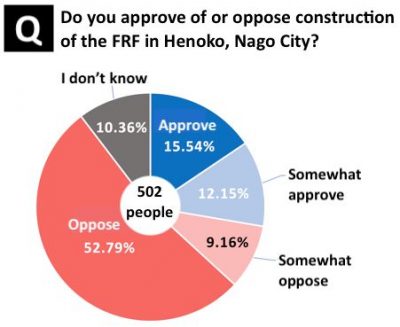
When asked about the construction of the FRF in Henoko, Nago City, most respondents, 52.79 percent, answered that they “oppose” construction. When this percentage is added to the 9.16 percent who answered that they “somewhat oppose” construction, the result is 61.95 percent of respondents opposing construction of the FRF. 15.54 percent of respondents “approve” and 27.69 percent “somewhat approve” of construction. 10.36 percent of respondents answered “I don’t know”.
Out of the people who selected “unconditional closure/removal” as their solution to the Futenma Air Station issue, the region most responsible for this response was the northern region of Okinawa Island at 44.07 percent. However, out of people who answered “relocate to Henoko, Nago City”, 22.73 percent were from the Miyako region, the region which gave this answer to a higher percent than any other region. This makes apparent the difference in opinion between regions.
People who answered that they do “not support” the Abe Cabinet accounted for 66.33 percent, greatly exceeding the 18.73 percent who “support” the Abe Cabinet. According to a national emergency telephone opinion poll conducted by Kyodo News in late May, the Abe Cabinet’s approval rate was 39.4 percent, and its disapproval rate was 45.5 percent. This makes clear just how much more critically the administration is viewed within Okinawa in comparison to in Japan as a whole.
(English translation by T&CT and Erin Jones)
Go to Japanese
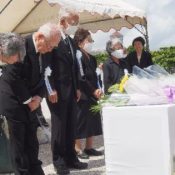
June 19, 2020 Ryukyu Shimpo
On June 18, a WWII gakuto-tai alumni association held a memorial ceremony to honor their fallen classmates at the Peace Memorial Park in Mabuni, Itoman City. The gakuto-tai association comprises alumni from 21 schools that were mobilized by the Imperial Japanese Army as student-soldiers to fight in the Battle of Okinawa. The memorial service was originally scheduled for March but was postponed due to the novel coronavirus outbreak. Only 20 former gakuto-tai members and close associates attended, as the event was downsized and closed to the public. The group prayed that the future generations will carry on their pursuit of peace.
Shoken Yoza, 91, was drafted at age 16, when he was a fourth-year student at the prefectural middle school (current day Shuri High School). Yoza, who now co-heads the gakuto-tai alumni association, stood before the Cenotaph for all Student Corps (Zen Gakuto-tai no Hi) and read outloud a peace declaration. Yoza hopes that the younger generation will become champions for peace on Okinawa. He said, “Our ultimate wish is for a conflict-free society without war.”
Kiku Nakayama, 91, was a fourth-year student at the Okinawa Daini Girls High School when she was summoned. She co-heads the gakuto-tai association with Yoza. She said, “I hope that next year we can get the younger generation involved, and tell the rest of Japan and the world, ‘nuchi du takara’ (an Okinawan expression meaning life is precious) and that peace is ichiban (number one).”
Seisaburo Miyagi, secretary of the gakuto-tai alumni association wrote in a letter, “Protecting the Japanese Constitution is truly the road to peace. I will not forget that this is what my fallen classmates would have wished for, and I will advocate antiwar and pacifism as long as I live.”
During the Battle of Okinawa, school boys were conscripted at age 14 and school girls at age 15, to be sent into the battlefields. The surviving gakuto-tai members requested the prefecture to build a cenotaph for their fallen classmates, and in March 2017 the prefecture erected the Cenotaph for All Student Corps (Zen Gakuto-tai no Hi) in Itoman City. In March 2018, a plaque bearing the names of the 1,984 war-dead student-soldiers was installed.
(English translation by T&CT and Monica Shingaki)
go to japanese
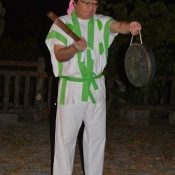
June 18, 2020 Ryukyu Shimpo
Itoman – At approximately 5 a.m. on June 18, the ringing of the gong that signals the coming of Itoman Hare Dragon Boat Race season was held at Santinmo in Itoman, Itoman City. Around ten citizens had gathered to watch over the event and pray for safety of fishers at sea and an end to the novel coronavirus pandemic. As night ended and the sky began to lighten, the sound of the gong rang through the city.
The ringing of the gong is normally held before the Itoman Hare Dragon Boat Races begin on the 4th day of the 5th month of the lunar calendar (yukkanuhi; in 2020, June 24). This year, it was decided to cancel the Itoman Hare for the first time since World War II due to the spread of novel coronavirus. However, Hiroshi Higashionna, chair of the Itoman Hare Committee, said, “We should at least hold the ringing of the gong. We will pray for an end to coronavirus as well.” Because of his strong feelings that the gong should be rung, the event was held this year.
Higashionna hit the gong this year, clad in the green hare gin (traditional outfit) for Nakamura, from among the three villages of Nishimura, Nakamura, and Niijima. He addressed the onlookers. “With deep gratitude for the blessings of the sea, and with prayers for safety at sea and at home, and for the soonest possible end of the coronavirus pandemic,” he said. He quietly steadied his breath and then powerfully rang the gong, five times in each of the four cardinal directions.
After ringing the gong, Higashionna also performed the sanchin from karate. The onlookers continued to watch as the sound of his breathing and the sliding of his feet across the ground filled the morning air.
(English translation by T&CT and Ellen Huntley)
go to japanese

June 16, 2020 Ryukyu Shimpo Digital Edition
Okinawa Governor Denny Tamaki met with reporters at the Okinawa prefectural office the morning of June 16, where he commented on Japan’s June 15 announcement that they were abandoning their Aegis Ashore land-based missile defense system deployment to Akita and Yamaguchi prefectures, once again voicing his doubts about new base construction at Henoko, part of the effort to relocate MCAS Futenma, saying, “Considering the cost and time, the Henoko project is an even more wasteful construction project, isn’t it?”
On the morning of June 16, Governor Tamaki also touched on the issue via his personal twitter, where he tweeted, “It is clear that ‘if MCAS Futenma is not closed immediately without relocating to Henoko, then the original intention, to reduce the base burden, is not being realized.’”
(English translation by T&CT and Sam Grieb)
go to japanese
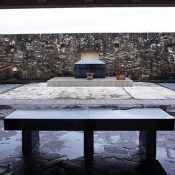
June 13, 2020 Ryukyu Shimpo
As of June 12, the Okinawa Peace Memorial Foundation has deleted from its website the wording “eternally houses the remains of war dead who sacrificed their lives for the nation in a time of national peril” as an explanation of the National War Cemetery of Okinawa. The statement now reads, “people whose lives were sacrificed in the tragic war.”
Last month, Governor Denny Tamaki announced that as the Okinawa Memorial Day ceremony to honor all those who died in the war in Okinawa would be held at a smaller scale in light of the coronavirus pandemic, the venue for the ceremony would be changed to the National War Cemetery of Okinawa. On June 12, it was announced that the ceremony will be held at its usual location after all. Between the original announcement and the switch back, Okinawa International University Professor Emeritus Masaie Ishihara and others problematized the fact that the cemetery’s website included the war-glorifying phrase “war dead who sacrificed their lives for the nation in a time of national peril,” asserting that holding the ceremony at the cemetery would not align with the sentiment of survivors and families of the dead.
Okinawa Peace Memorial Foundation Managing Director Kenji Uehara explained that the phrase “sacrificed their lives for the nation in a time of national peril” was added to the website when it was renewed in May of last year, with reference to newsletters published by associations for families of war dead in other prefectures. “Hearing the critique of Professor Ishihara and others, we believe that it is not appropriate to continue using this wording, and we changed the wording to what it was before the [website] renewal. We didn’t fully consider the implications of the ‘national peril’ phrasing. I’m very sorry,” Uehara said.
(English translation by T&CT and Sandi Aritza)
go to japanese
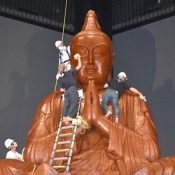
June 12, 2020 Ryukyu Shimpo
Mabuni, Itoman City—the Peace Prayer Statue, enshrined in the Okinawa Peace Memorial Hall (Heiwa Kinendo), was dusted down during a “cleansing” ritual on June 11, days ahead of the Okinawa Memorial Day for the War-dead which falls on June 23. The number of staff tasked with this ritual was reduced to eight this year, as a precautionary measure against the novel coronavirus. Given that 2020 marks the 75th anniversary of the end of WWII, master craftsmen were also commissioned to apply a fresh coat of lacquer to the statue for the first time in twelve years.
The Peace Prayer Statue stands about 12 meters tall and about 8 meters wide. To dust the statue, the workers climbed on ladders and took stock of any cracks and overall deterioration.
Seiji Itokazu, 65, a former professor of Okinawa Prefectural University of Arts, had a hand in building the Peace Prayer Statue. He wiped the sweat off of his forehead and said, “It’s a small act, but this cleaning ritual is a prayer for world peace.” Tetsuya Mori, 43, a lacquer craftsman who helped restore Shuri Castle said, “The Peace Prayer Statue is not for one religion, race, or nationality. I hope that the statue will remain decades and centuries down the road, and inspire people to think about peace.”
The annual memorial service for Okinawa’s war-dead will be held at the Okinawa Peace Memorial Hall at 3 p.m. on June 22. Due to the coronavirus outbreak, the service will be scaled down and closed to the public.
(English translation by T&CT and Monica Shingaki)
go to japanese

June 14, 2020 Ryukyu Shimpo
In the Janabishi coral reef, around one kilometer from the Ginowan Marina in Ginowan, the table coral and midori-ishi coral in the reef were seen releasing all of their eggs at once at around 10:20 p.m. on June 10. Toru Higaonna, 47, who runs a diving shop in Naha, was able to capture the event in a photograph.
Higaonna had been visiting the area for around a week during the spring tide, but had yet to see the coral laying eggs. Then, he discovered some eggs during a half tide just after a spring tide on June 9 before witnessing the mass egg-laying event on the following day. “For the past two, three years, poor weather prevented me from going out in a boat. I am glad I was able to go out uninterrupted this year,” he said, happy that we has able to see the mystical scene play out before him.
(English translation by T&CT and Sam Grieb)
go to japanese

June 11, 2020 by Ryukyu Shimpo
Ishigaki – The Okinawa Defense Bureau (ODB) resumed construction of a base in the Omata neighborhood of Hirae-Omata, Ishigaki June 10, as part of a larger plan to deploy the Japanese Ground Self-Defense Force (JGSDF) to the region. On that day, loud construction noises were not heard in the area, however local resident organizations voiced their concern over the decision to re-start construction, as they had requested that construction be suspended until the end of the crested serpent eagle breeding season. The area residents are concerned about the noise generated by construction. It had been confirmed that a crested serpent eagle, a protected species in Japan, had been nesting near the construction area, and construction was suspended May 20.
The ODB has implemented policies such as “temporarily refraining from activities that could create sudden noise such as rock crushing” near the confirmed nesting location, based on expert opinion and in coordination with the city. According to the city’s cultural asset department, after the nest was discovered, the city conferred with two additional local specialists in addition to the ODB’s expert. The specialists confirmed that “The ODB’s policies should reduce the possibility the eagle abandons its nest,” and as a result on June 8 Ishigaki City notified the ODB they would be allowed to resume construction.
Zen Minei, 54, a representative of the Ishigaki city citizen’s liaison council, which opposes the building of a new military base on Ishigaki Island, said, “They should disclose for example who this expert is. Crested serpent eagles have been spotted in a number of locations in the area, and there is much we still do not know. As such, we are still doubtful that these policies are good enough.”
Before the suspension of construction, area residents had complained to the ODB and the city that the noise from breaking up stones was bothering them. Heiji Kobayashi, 58, who runs the community center in Kainan, next to the construction site, said, “It is going to get increasingly hot from here on, but that does not mean we can run the air conditioner all the time. The banging noises of the rock crushing on hot days is fairly unpleasant. There have been no attempts to stifle the noise, or even any data about the noise released, which shows a lack of consideration,” noting his distrust of the ODB.
(English translation by T&CT and Sam Grieb)
go to japanese
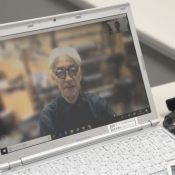
June 11, 2020 Ryukyu Shimpo
By Sadaharu Shimabukuro
World-renowned musician Ryuichi Sakamoto spoke to Ryukyu Shimpo’s Editor-In-Chief Tsuyoshi Matsumoto in a remote interview from his home in New York. He weighed in on the Henoko base construction issue and the global threat of the coronavirus pandemic. In the interview, Sakamoto pointed out that Japan’s national challenges are shouldered by certain places in Japan. For example, in issues of national security, Okinawa bears the brunt of hosting U.S.
military bases, while Fukushima is made to contend with its nuclear power plants when it comes to energy sources. He commented, “Japan’s democracy is very peculiar, it’s distorted in my opinion. The government elites are undemocratic and dictatorial.” He added, “We have an undemocratic administration but most people don’t protest its absurdity. It’s because our democracy isn’t well-established.”
In April, in the midst of the coronavirus outbreak, the Japanese government submitted a revised construction plan for the new base to the prefectural government, after the discovery of the soft seabed at Henoko bay. Sakamoto wondered out loud, “If you think about it rationally, the construction project in Henoko will fail. Even if they finish building the base, I don’t think it will be operable. [The government] just wants to show that they are taking action. Should we be wasting important taxpayer money? The [administration’s] spending in response to the novel coronavirus outbreak is also questionable.”
On the topic of the Abe administration’s management of the coronavirus outbreak, Sakamoto said that its tendency to neglect democratic processes is presenting barriers. The musician spoke on how other countries around the world were dealing with the pandemic, and questioned Japan’s relief package as well as pointing out the lack of transparency in its COVID-19-related decision-making processes.
In his analysis, excessive global urbanization contributed to the world-wide spread of COVID-19. Sakamoto warns that: “Environmental destruction continues due to global urbanization. If we don’t change human and economic activities to coexist with nature, more of these challenges will continue to arise.”
Looking ahead to a post-COVID-19 world, Sakamoto underscored the need for change in urban lifestyles. “We need to improve urban designs, which would also mean massive public projects. At this time when our economy is depressed, public projects would be far more significant than building an unusable military base.”
In January, the musician performed in Okinawa for the first time and played the piano in a concert held in Ginowan City. He had visited Henoko bay during the trip.
English translation by (T&CT and Monica Shingaki)
go to japanese














 Webcam(Kokusai Street)
Webcam(Kokusai Street)


